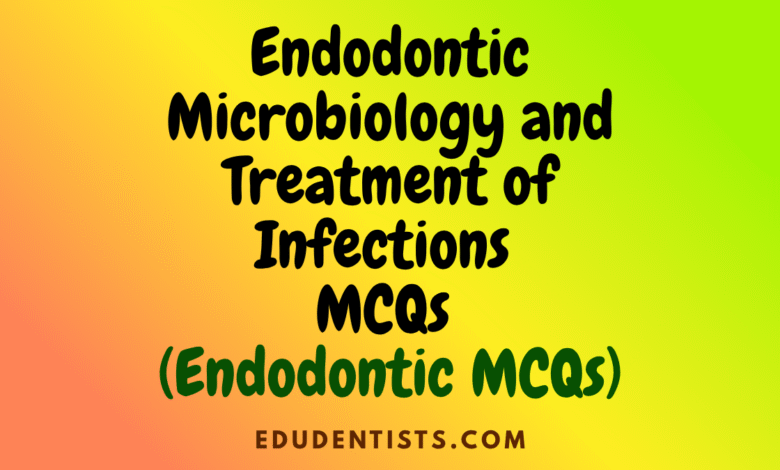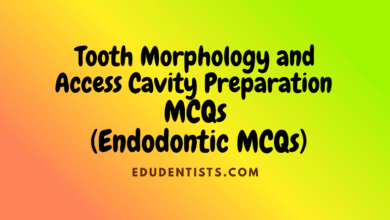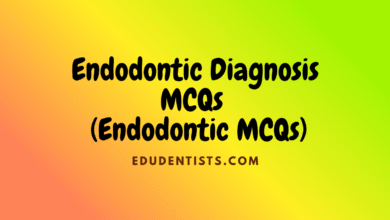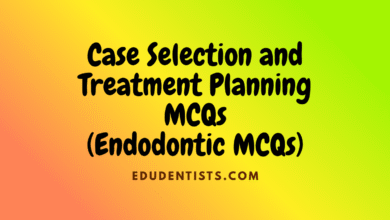Endodontic Microbiology and Treatment of Infections (Endodontic MCQs)
Endodontic Microbiology and Treatment of Infections (Endodontic MCQs)

Endodontic Microbiology and Treatment of Infections (Endodontic MCQs)
Endodontic Microbiology and Treatment of Infections (Endodontic MCQs)
1. Pulpal and periradicular pathosis results primarily from which of the following
A) Traumatic injury caused by heat during cavity preparation
B) Bacterial inva sion
C) Toxicity of dental materials
D) Immunologic reactions
2. Which of the following statements about the organism that causes pulpal pathosis is correct:
A) The organisms are primarily facultative streptococci.
B) Single isolates (i.e., monoinfection) produce the severest reactions.
C) Isolates tend to be polymicrobial and anaerobic.
D) Organisms that infect the pulp tend to be aerobic, unlike organisms that infect the periapex.
3. Which of the following best describes anachoresis:
A) The attraction of blood-borne microorganisms to inflamed tissue during a bacteremia
B) The process of carious invasion, cavitation, and exposure of the pulp caused by bacteria
C) Bacteria in the dentinal tubules and pulp are seeded to the systemic circulation, inducing disease in other areas of the body.
4. Which of the following statements about strict anaerobes is accurate:
A) They are missing enzymes, catalase, and superoxide dismutase.
B) They function best at high oxidation-reduction potentials.
C) They can grow in the presence of oxygen.
D) All of the above
5. Which of the following is the black-pigmented bacteria most commonly detected by molecular methods from endodontic infections:
A) Bacteroides melaninogaster
B) Fusobacterium nucleatum
C) Prevotella nigrescens
D) Porphyromonas intermedia
6. Treatment of Actinomyces israelii may include which of the following:
A) Root canal treatment
B) Root-end surgery
C) Antibiotics
D) All of the above
7. Which of the following statements about microbial virulence factors is true:
A) Fimbriae assist in bacterial aggregation.
B) Pili break off and form extracellular vesicles filled with enzymes.
C) Lipopolysaccharides are found in the liposomes of gram-positive bacteria.
D) All of the above
8. Which of the following statements about polyamines is accurate:
A) They are produced by bacteria and host cells.
B) They may be found in infected root canals.
C) They are more concentrated in teeth with spontaneous pain.
D) All of the above
9. Which of the following statements about fascial space infections is accurate:
A) They are associated with radiographically visible periradicular lesions.
B) They occur in potential spaces between fascia and underlying tissue.
C) They occur when a tooth apex is located coronal to a muscle attachment.
D) All of the above
10. Which of the following statements about Ludwigs angina is accurate:
A) It involves the submental, sublingual, and submandibular spaces of the right or left side.
B) It can progress into the canine and infraorbital spaces.
C) It can cause airway obstruction.
11. Antibiotics are recommended for which of the following:
A) Sinus tracts
B) Acute, apical periodontitis
C) After root-end surgery
D) None of the above
12. An incision and drainage procedure is indicated for which of the following:
A) For sinus tracts
B) When swelling is diffuse and indurated
C) For acute, apical periodontitis
D) All of the above
13. An incision and drainage procedure is effective for cellulitis because:
A) It provides a pathway of drainage, preventing the spread of infection.
B) It relieves increased tissue pressure.
C) It provides pain relief.
D) It increases circulation to the area and improves delivery of antibiotics.
E) All of the above
14. Which of the following statements about potassium penicillin VK is accurate:
A) It has a broader spectrum of action than amoxicillin.
B) It may be dosed at 4-hour intervals for severe infection.
C) It will select for resistant organisms, especially in the gastrointestinal tract.
D) It has an allergy rate of up to 25.
15. Which of the following statements about metronidazole is accurate:
A) It is effective against facultative and anaerobic bacteria.
B) It cannot be given with penicillin because of the risk of a disulfiram reaction.
C) It cannot be taken with lithium or alcohol.
16. Which of the following statements about clindamycin is accurate:
A) It is an alternative to potassium penicillin VK for allergic individuals.
B) It is effective against facultative and anaerobic bacteria.
C) It is rarely associated with pseudomembranous colitis in the doses recommended for endodontic infections.
D) All of the above
17. Which of the following statements about the American Heart Association (AHA) guidelines for prophylactic antibiotic coverage is accurate:
A) They are the standard of care for clinicians.
B) They are based on controlled clinical studies.
C) They are not a substitute for clinical judgment.
18. The AHA recommends antibiotic prophylaxis for which of the following:
A) Surgery
B) Instrumentation beyond the apex
C) Periodontal ligament injection
D) All of the above
19. Which of the following statements about the theory of focal infection is accurate:
A) It was propounded by Dr. William Hunter in 1910.
B) It referred to infections found around poorly made restorations.
C) It was used to explain diseases for which no cure existed.
D) It results in needless tooth extraction.
E) All of the above
20. Which one of the following statements is false:
A) Gram-negative bacteria have been associated with endodontic infections.
B) Facultative anaerobic bacteria can grow in the presence or absence of oxygen.
C) Obligate anaerobic bacteria lack catalase.
D) Cultures of root canals reveal that obligate anaerobes make up approximately 60 of the total bacterial count.
21. Which one of the following statements is false:
A) DNA-DNA hybridization use DNA probes.
B) Polymerase Chain Reaction (PCR) method involves in vitro replication of DNA.
C) A low percentage of anaerobic gram-negative bacteria are found in primary root canal infections.
D) Enterococcus faecalis is the primary microbe in root canals undergoing retreatment.
22. Which of the following organisms have been detected in periapical lesions:
A) Spirochetes
B) Human Cytomegalovirus (HCMV)
C) Epstein-Barr virus (EBV)
D) Candida albicans
E) All of the above
23. Which of the following polymerase chain reaction (PCR) techniques is not used to target specific microorganisms:
A) Real-time PCR
B) Nested PCR
C) RT-PCR
D) Multiplex PCR
E) Broad-range PCR
24. Which of the following is the most sensitive identification method:
A) DNA-DNA checkerboard
B) Microbial cultivation
C) PCR
D) Scanning electron microscopy (SEM)





